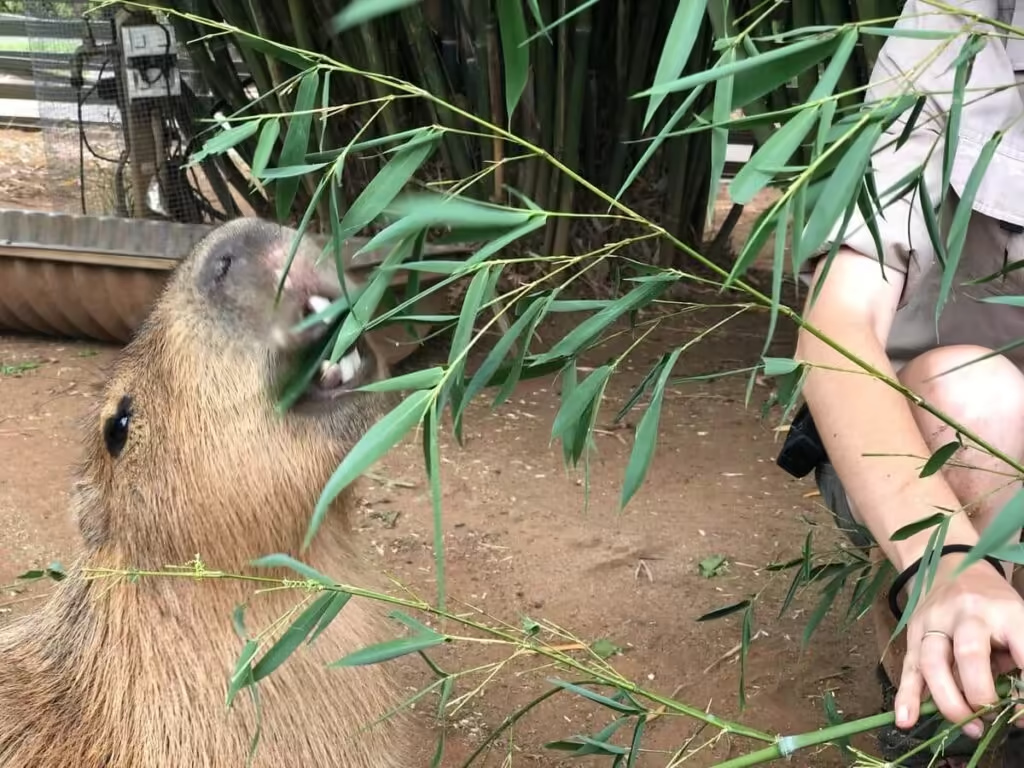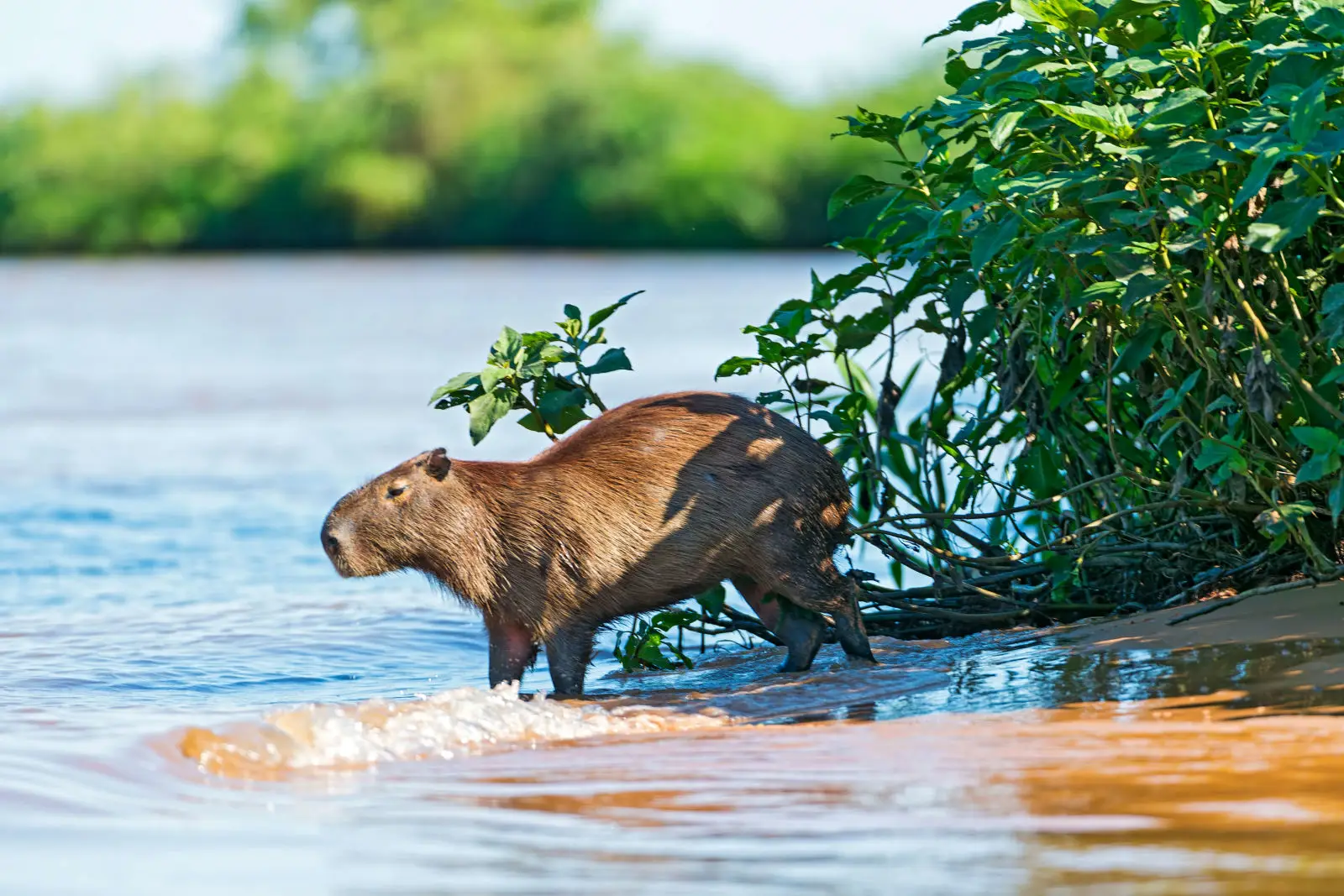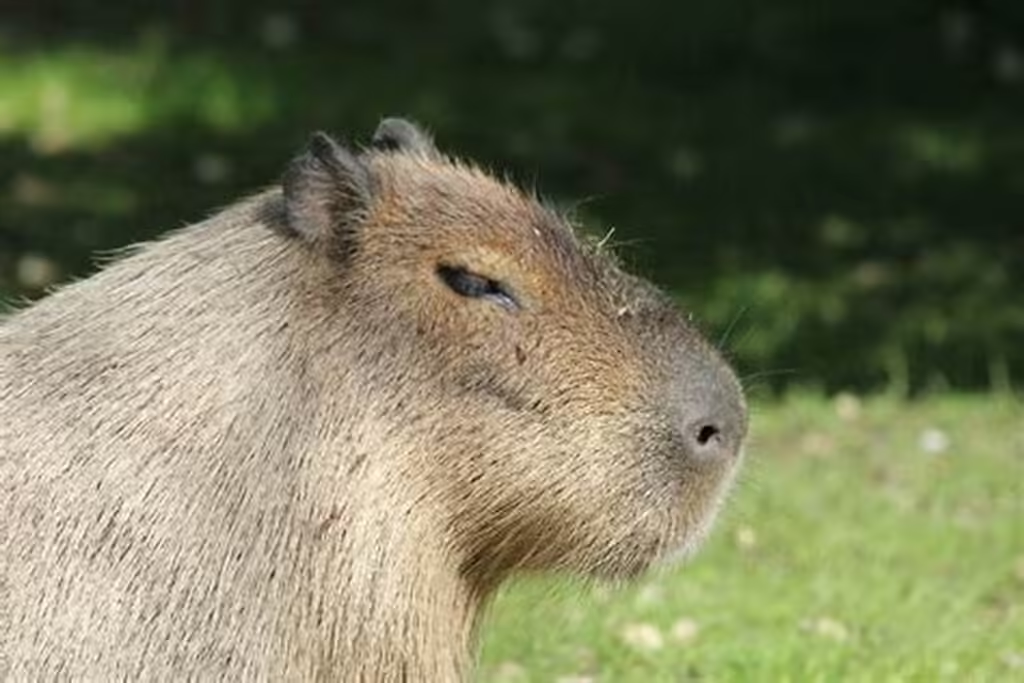We’re going to look into what capybaras eat, if they eat meat and the details of their diet and eating habits.
Key Takeaways
- Capybaras are herbivores, mainly eating grasses, water plants, and other plants.
- They don’t usually eat meat, but they might eat some insects or dead animals now and then.
- Capybaras have special digestive systems that help them get nutrients from plants.
- The way they eat and what they prefer to eat is important for their home environments.
- Knowing what capybaras eat is key to taking good care of them in the wild or captivity.
Introduction to Capybaras
Capybaras are the biggest rodents alive today. They live in the wetlands of South America. They love the wetlands, living in savannas, marshes, and by rivers and lakes. Their looks and how they adapt to their home make them interesting to many people.
What are Capybaras?
Capybaras are part of the Hydrochoerus group, meaning “water hog” in Greek. They can weigh up to 150 pounds, making them the biggest rodents alive. They have big bodies, short legs, and webbed feet perfect for the water.
Their Natural Habitat
Capybaras live in wetlands across South America, like the Amazon, Pantanal, and grasslands of Venezuela and Colombia. They like places with lots of water, like rivers, lakes, and swamps. Here, they swim, eat, and rest.
They can also live in cities and farms if there’s enough water and plants. Their ability to live in different places has helped them do well as a species.
Do Capybaras Eat Meat?
Many people think capybaras eat meat, but they don’t. They are herbivores, eating mostly plants. These big rodents love to eat grasses, water plants, fruits, and veggies.
Capybaras might eat some insects or dead animals now and then. But they are not true carnivores. Their bodies are made to digest plant food, fitting their plant-eating way of life.
| Capybara Diet Composition | Percentage |
|---|---|
| Grasses and Aquatic Plants | 70-80% |
| Fruits and Vegetables | 20-30% |
| Occasional Animal Matter | Less than 5% |
To sum up, capybaras are mostly herbivores or omnivores. They eat mostly plants. Eating animal matter is rare and not a big part of their diet.
Capybara Diet Breakdown
Capybaras are amazing creatures with a wide range of food choices. They are the biggest rodents and live in water. They eat a lot of grasses and plants that grow in the water. But they don’t just eat plants; they also have fruits, veggies, and animal food.
Preferred Food Sources
The capybara’s diet is mostly grasses and water plants. They love to eat water hyacinths, water lettuce, and water lilies. These plants give them the carbs, proteins, and fiber they need to stay healthy and active.
- Grasses, including various species of the Poaceae family
- Aquatic plants, such as water hyacinth, water lettuce, and water lilies
- Succulent plants and herbs found near their watering holes
Occasional Dietary Supplements
Capybaras also eat other foods besides plants. These foods help them get all the nutrients they need. Some of these foods are:
- Fruits, like berries, melons, and fruits that fall from trees
- Vegetables, including leafy greens, roots, and tubers
- Small amounts of animal matter, like insects, small fish, or carrion
- Minerals and other nutrients obtained by consuming soil or rocks
Grazing Habits and Behaviors
Capybaras are known for their unique way of eating, often eating together in groups. Their eating habits change based on the time of day, water availability, and other animals around them.
One interesting thing about capybaras is how they eat together. They usually eat in groups, with some watching for predators while others eat. This way, they stay safe and work together to find food.
The way capybaras eat is closely linked to their eating habits. These big rodents are most active in the early morning and late afternoon. During these times, they eat a variety of plants, like grasses, water plants, and fallen fruits.
Water is very important for capybaras. They live in places with lots of water, like marshes and riverbanks. Here, they can eat, take shelter, and hang out with each other.
Learning about how capybaras eat and live together helps us understand their role in nature. It also tells us why we need to protect them.
| Behavior | Description |
|---|---|
| Group Grazing | Capybaras often feed in groups, with individuals taking turns keeping watch for predators. |
| Time of Day | Capybaras are most active and graze during the early morning and late afternoon hours. |
| Water Dependence | Capybaras thrive in areas with abundant water sources, where they can graze, seek refuge, and socialize. |
Digestion and Nutrition Needs
Capybaras are the biggest rodents in the world. They have a special way of digesting food because of their size. These herbivores eat mostly plants to keep their big bodies going. Their digestive system shows how nature helps them live well in their homes.
Digestive System Adaptations
The capybara’s large cecum is key to their digestion. This pouch-like part of their gut is where food ferments. It helps them break down hard plants and get all the nutrients they need.
Their capybara digestive system also digests food slowly. This lets them get every bit of capybara nutritional requirements from their food. These special ways of digesting are vital for their survival.
Because of these capybara digestion adaptations, they can get enough energy and nutrients from a tough diet. Learning about their digestive system helps us understand what they need to stay healthy.
Capybara Feeding in Captivity
Keeping capybaras healthy in places like zoos and wildlife parks means paying close attention to their dietary needs. It’s important to make their diet similar to what they eat in the wild. This helps them grow well and live a long life.
For feeding capybaras in captivity, it’s key to know what they need to eat. These animals eat plants like grasses and aquatic plants in the wild. In captivity, their food should be as similar as possible to what they find in nature.
Ensuring a varied and nutritious diet is a big part of caring for capybaras. They should get different types of grasses, leafy greens, and aquatic plants. Sometimes, adding fruits and vegetables can make their meals more interesting and give them all the nutrients they need.
| Preferred Food Sources for Captive Capybaras | Occasional Dietary Supplements |
|---|---|
|
|
By giving capybaras in zoos a diet that’s close to their wild diet, they can do well in captivity. It’s important to watch how they eat and change their food as needed. This way, each capybara gets what it likes and needs.
Impact of Diet on Capybara Health
The capybara’s diet is key to their health and happiness. They need the right mix of nutrients, minerals, and fiber. This balance helps avoid common dietary issues in capybaras, capybara nutritional deficiencies, and capybara digestive problems.
Potential Dietary Concerns
One big issue with their diet is digestive problems. Being herbivores, they eat mainly grasses, aquatic plants, and other plants. But, eating the wrong foods can cause stomach issues like constipation, diarrhea, or impaction.
- Not getting enough vitamins or minerals can also hurt their health.
- They can also have trouble with weight, either getting too fat or too thin.
Captive capybaras face special diet challenges. They might not get to eat a variety of foods. So, vets and those taking care of them must watch their diet closely. They need to make changes to keep the capybaras healthy.
| Dietary Concern | Potential Impact | Preventive Measures |
|---|---|---|
| Digestive Problems | Constipation, diarrhea, impaction | Provide a balanced, fiber-rich diet with proper hydration |
| Nutritional Deficiencies | Various health issues weakened immune system | Supplement the diet with appropriate vitamins and minerals |
| Weight Management | Obesity or malnutrition | Monitor food intake and adjust the diet as needed to maintain a healthy weight |
Knowing how diet affects capybara health helps caretakers. They can take steps to keep these interesting rodents healthy for a long time.
Interesting Capybara Food Facts
Capybaras, the biggest rodents, show some amazing behaviors and adaptations with their diet. Their capybara food preferences and dietary adaptations show how they’ve evolved to live well in their homes.
One cool fun fact about the capybara diet is how they use their big, webbed feet to spread their weight while eating plants in the water. This lets them go deeper into the water without sinking. It gives them more capybara food sources to choose from.
Another cool unique capybara eating habit is how they can hold their breath for up to five minutes underwater. This lets them search for plants that grow under the water. These plants are a big part of their capybara diet.
Capybaras are experts at eating a variety of plants, from grasses and water plants to fruits and even tree bark. Their capybara food preferences help them live in different places and stay alive in their natural homes.
- Capybaras use their large, webbed feet to distribute their weight while grazing on aquatic plants.
- They can hold their breath for up to five minutes while submerged in water, allowing them to forage for submerged vegetation.
- Capybaras are highly adaptable, with the ability to thrive on a wide range of plant materials, from grasses and aquatic plants to fruits and tree bark.
Conserving Capybara Habitats
Keeping the natural homes of capybaras safe is key to their survival. We must protect their wetland homes and make sure they have enough food, like grasses and plants. Conservation efforts are vital to keep capybara numbers stable and protect their environments.
Protecting Their Food Sources
Capybaras need a variety of plants to eat. Keeping their food sources safe, like grasslands and water plants, is crucial. This helps keep capybara populations healthy and their ecosystem balanced.
We must fight threats to their homes, like losing land, pollution, and bad land use. Working with local people, leaders, and conservation groups can help protect capybara habitats. This ensures these amazing animals can thrive for a long time.



